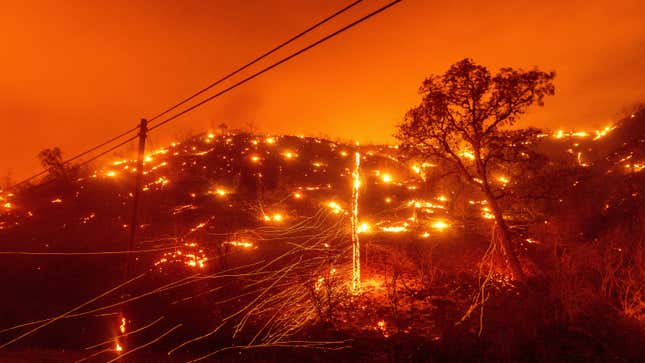
If you haven’t already heard, California is on fire. Gov. Gavin Newsom declared a state of emergency on Tuesday for the disaster unfurling. The state is in the middle of a dramatic heat wave, which is fueling more than 30 wildfires burning across the state. The situation appears to be going from bad to worse.
The madness kicked off this past weekend with rolling blackouts right as people cranked up their air conditioning to deal with the heat. Just when you’d think things couldn’t get worse than losing power during a heat wave, the National Weather Service issued its first-ever tornado warning for a fire-induced twister. If you were still unsure, 2020 is now officially the year hell took over Earth. Unfortunately, the state’s weather conditions aren’t getting any better, which is exacerbating this precarious situation.
Nearly 100,000 acres of land are burning throughout the state with the SCU Lightning Complex Fire near San Jose and LNU Lightning Complex Fire near Napa the largest ones at the moment. Both are have burned upwards of 32,000 acres with about zero containment. The LNU Lightning Complex Fire even destroyed a camera the state depends on to monitor fires, and its final fiery broadcast was captured in the image below. These events have prompted evacuation orders throughout the regions, including at least 22,000 people in the vicinity of the CZU Lightning Complex Fire in Santa Cruz and San Mateo counties alone.
Meanwhile, there are some 37,000 people, per CNN, who remain without power. These conditions are terrifying, to say the least. Without power, families may struggle to stay tuned in to how the situation continues to unfold around them and evacuation notices may be easier to miss. When a wildfire is bearing down, every minute of notice is critical.
The wildfires have caused air quality to deteriorate, too. The Bay Area Air Quality Management District issued an alert on Tuesday banning residents from burning any wood or solid fuel indoors and outdoors through Wednesday. The region is experiencing “elevated levels of particulate pollution,” the district reported, and any further burning would worsen the air quality. Air pollution comes with health consequences, but this year it’s even more urgent with the coronavirus pandemic creating a new respiratory health crisis. Some studies have found evidence that air pollution can heighten the risk of death in those sick with the virus, and California is currently dealing with one of the worst outbreaks in the U.S.
The horror unfolding in California is closely tied with rising global temperatures, which increase the odds of large, destructive wildfires. The state has seen a number of destructive wildfire seasons recently, including 2018 that saw the most destructive and largest fires in state history. What’s more, these fires are further contributing to the crisis. Each forest that burns emits more greenhouse gases into the atmosphere.
While the state can adapt to a degree, that would provide some temporary relief from the flames. The true solution is reducing greenhouse gas emissions globally. But even then, we’re living in a new era of large wildfires. In California’s case, residents may have to face the reality that it’s too dangerous to build (or rebuild) homes at the wildfire-urban interface.